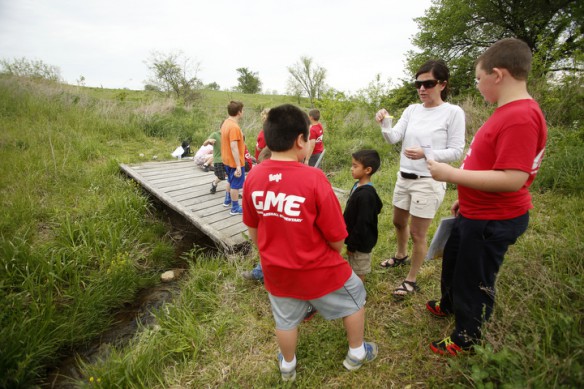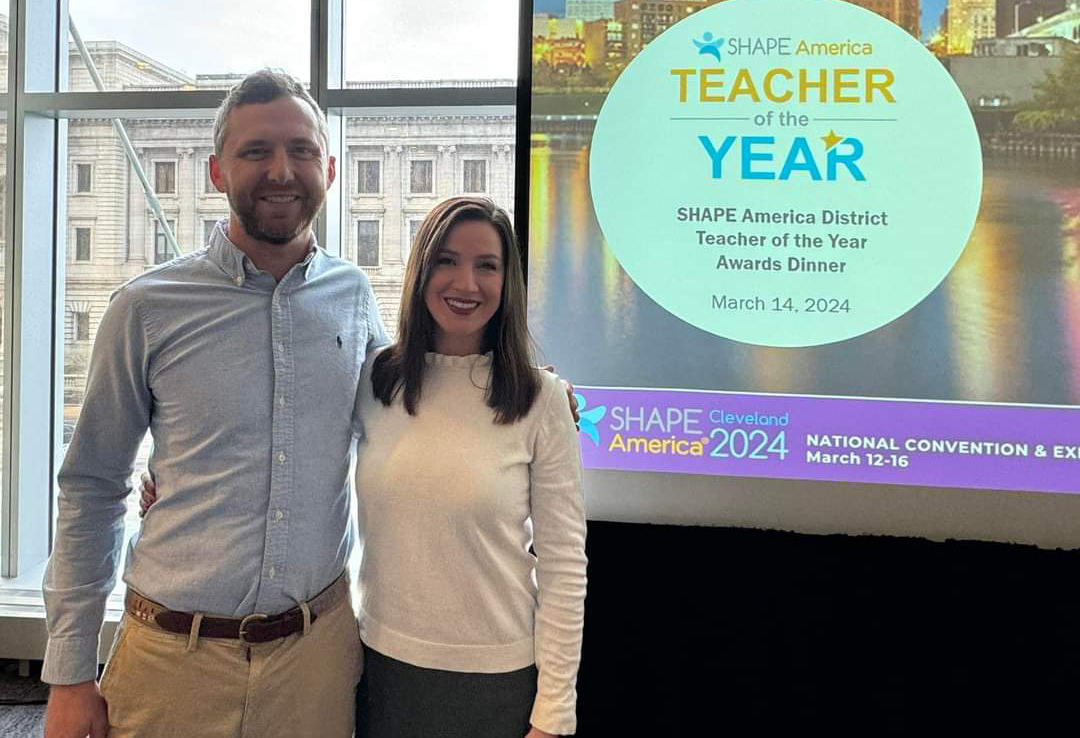
Science teacher Christy Johnson instructs 2nd-and 4th-grade students how to take water samples from a stream and test it for various nutrient levels at Glenn Marshall Elementary School (Madison County)
Photo by Amy Wallot, May 9, 2014
By Brenna R. Kelly
Brenna.kelly@education.ky.gov
Christy Johnson knows that not every elementary school has an evolving ecosystem on campus, so the 4th-grade science teacher walks her students to the outdoor classroom at Glenn Marshall Elementary every chance she gets.
“We go out all the time and utilize it,” she said. “I always try to integrate it into something that we are talking about.”
On a cloudy day in May, the 4th- and 2nd-grade students at Glenn Marshall (Madison County) trekked across campus to the classroom which includes a wetland, stream and shelter. The students fished for tadpoles with nets, dipped test tubes into the stream, peered at wiggling insects through microscopes and watched a biologist catch and tag birds.
“That outdoor classroom it is just a wealth of opportunity for hands-on lessons,” Johnson said. “Definitely for the life science, the biology, but there’s opportunities for physical science as well.”
Students and teachers at Glenn Marshall and B. Michael Caudill Middle School, which shares the campus, have been watching the wetland area develop since 2012 when it was constructed in a drainage basin.
The project was collaboration between the schools’ science teachers and Eastern Kentucky University, which received an $8,800 Bluegrass PRIDE grant for the project. Johnson and EKU biology professors Stephen Richter and David Brown also worked with Tom Biebighauser, a wildlife biologist and wetland ecologist, who has helped more than 120 teachers build wetlands for outdoor classrooms.
Now that the wetland is thriving, Brown and Richter, who each have children at Glenn Marshall, often return to help Johnson and other teachers with outdoor classroom days.
On this day, Richter was in the wetland using nets to fish out tadpoles, frogs and other creatures to show the students the life cycle of a frog.
“It’s a pretty healthy community already,” said Richter, who also showed students how water scorpions use a needle-like mouth to stab a tadpole.
“It eats it like through a straw,” he said. “There are diving beetles and dragonfly larvae that eat in a similar way. Those critters and stories get the kids are really excited.”
In another area, Brown used a mist net to catch birds and put bands on their legs while teaching the students about the birds’ habitats and why they live in the wetland area. Johnson spent the day on a small bridge over the stream where she helped students test the water’s quality.
“That’s something that we do on a regular basis because the quality of the water in the stream is also an indicator of the effectiveness of the wetland,” she said.
In the shelter, Scott Darst, a Madison County UK cooperative extension agent, manned field microscopes where students examined dragon fly larvae, copepods and other invertebrates. At each station, the teachers talked about concepts the students had already learned in class and expanded on them.
“It’s giving them hands on experience, that’s one of the most important outcomes, I think,” said Richter. “Just being able to take things they’ve learned about in the classroom and actually get to witness it outside.”
The outdoor classroom is likely to see many more visitors from the schools as teachers begin implementing the new Kentucky Core Academic Standards for Science, Johnson said.
“I do think the new science standards and the way that it’s organized, that it does lend itself to a lot more hands on instruction,” she said.
The new science standards turn away from memorization of basic science concepts and require students to engage in authentic learning experiences in the practice of science and engineering, said Christine Duke, Kentucky Department of Education science consultant. Encouraging the exploration of natural phenomena will promote problem solving skills, deeper thinking and greater understanding of science concepts, she said.
“Outdoor education and outdoor science instruction are just a natural fit and relate to the dimensions of our new standards. It’s just a place for a great deal of authentic learning to occur,” Duke said. “What better place to experience natural phenomena than where it occurs.”
An outdoor classroom would be particularly useful in lessons based on the NGSS life science and earth science progression for grades kindergarten through 12, she said.
In addition to hands-on science instruction, an outdoor classroom is the perfect place for students to learn about both natural world and its interaction with man-made surroundings, said Elizabeth Schmitz, executive director of the Kentucky Environmental Education Council.
“A really critical component of environmental education is that it’s experience based,” she said. “The ultimate goal is to not teach kids what to think, but to teach kids how to think, and then to foster in them an interest into taking actions that can help maintain that sustainable balance between man and the environment.”
The outdoor classroom at Glenn Marshall’s classroom is already meeting one of the goals of the council’s Kentucky Environmental Literacy Plan – having schools to use the grounds and buildings as ways to learn about the environment, she noted. The plan, which was adopted by the Board of Education in 2011, calls for students to be able to “recognize the components of healthy natural and manmade systems and the actions necessary to maintain, restore or improve them.”
The plan is designed to be implemented alongside the new science standards, she said. It not just elementary and middle school students who have benefited from the outdoor classroom, Richter also takes his EKU students there. It’s particularly useful during his class on ecology for elementary and middle school teachers, he said. As part of the class he shows teachers how they can build a wetland at their own school. EKU biology students also study the water quality at the site and track animals living in the area.
Someday a former Glenn Marshall student studying biology at EKU could return to the site.
But even if the wetland doesn’t inspire every student to pursue science as a career, the outdoor classroom “might change their perspective a little bit,” Richter said, “and get them thinking more about things that are outside and not in a digital device.”
MORE INFO …
Christy Johnson, Christy.johnson@madison.kyschools.us
Stephen Richter, Stephen.Richter@eku.edu
Christine Duke, Christine.Duke@education.ky.gov
Elizabeth Schmitz, Elizabeth.schmitz@ky.gov








Leave A Comment